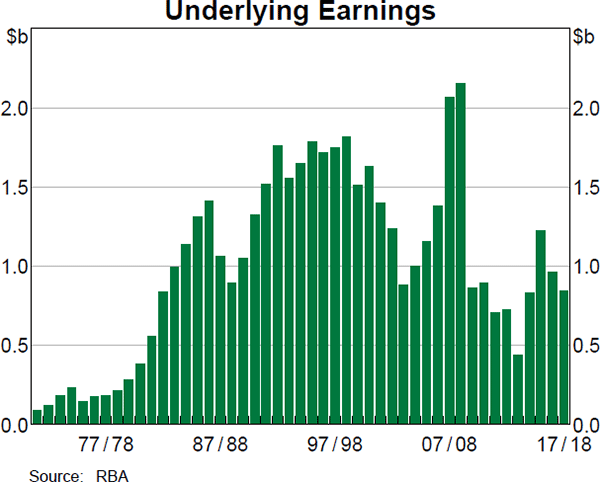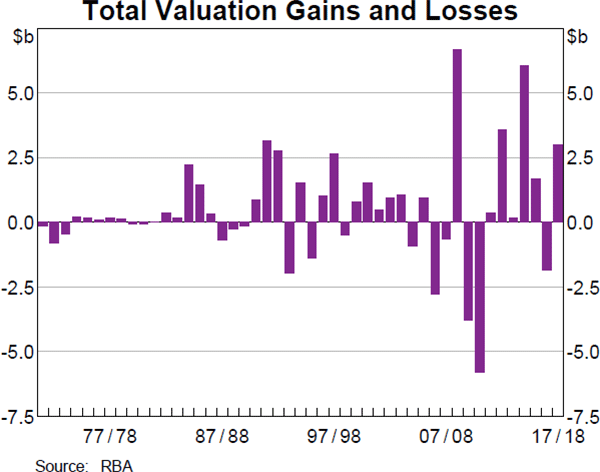Reserve Bank of Australia Annual Report – 2018 Earnings, Distribution and Capital
In 2017/18, the Reserve Bank recorded a net profit of $3.8 billion. In accordance with the Reserve Bank Act 1959, unrealised gains are not available for distribution and are transferred to the unrealised profits reserve. Earnings available for distribution amounted to $0.7 billion. The Reserve Bank remains well capitalised.
The Reserve Bank's Earnings
The Reserve Bank's earnings come from two sources: underlying earnings, comprising net interest and fee income, less operating costs; and valuation gains or losses. Net interest income arises because the Bank earns interest on almost all of its assets, albeit currently at low rates, while it pays no interest on a large portion of its liabilities, namely banknotes on issue and capital and reserves. Fees paid by authorised deposit-taking institutions in relation to the Committed Liquidity Facility also contribute significantly to underlying earnings.
Valuation gains and losses result from fluctuations in the value of the Reserve Bank's assets because of movements in exchange rates or in yields on securities it holds. A depreciation of the Australian dollar or a decline in interest rates results in valuation gains. Conversely, an appreciation of the Australian dollar or a rise in market yields leads to valuation losses. These gains and losses are realised only when the underlying asset is sold or matures. Valuation gains and losses are volatile, as both exchange rates and market interest rates fluctuate in wide ranges over time. Market risk is managed by the Bank within strict parameters, although it is not eliminated given the policy purposes for which the Bank's assets are held.
Management of the Bank's assets is discussed in the chapter on ‘Operations in Financial Markets’; the associated risks are considered in the chapter on ‘Risk Management’.
The Reserve Bank reports net profit as income from all sources, in accordance with Australian Accounting Standards, while the distribution of profits is determined by section 30 of the Reserve Bank Act. In terms of the act, net profit is distributed in the following way:
- Unrealised gains (or losses) are not available for distribution and are transferred to (absorbed by) the unrealised profits reserve. The remainder of net profit after this transfer is available for distribution.
- The Treasurer determines, after consultation with the Reserve Bank Board, any amounts to be placed from distributable earnings to the credit of the Reserve Bank Reserve Fund (RBRF), the Bank's general reserve.
- The remainder of distributable earnings after any transfer to the RBRF is payable as a dividend to the Commonwealth.
In 2017/18, the Reserve Bank recorded a net profit of $3,847 million, comprising:

- underlying earnings of $845 million, which were $115 million lower than the previous year. The decline in this component of earnings mainly reflected an increased use of foreign exchange swaps (rather than domestic securities) for domestic liquidity management purposes. The bulk of the foreign currency obtained from these swaps was invested in Japanese yen assets, which currently earn a very low or negative rate of interest. On a ‘total returns’ basis, earnings on foreign exchange swaps were generally higher than domestic securities of equivalent term as the total return from swaps includes the cost of hedging the currency risk, which was favourable during 2017/18, but recorded as an unrealised foreign currency gain rather than as underlying earnings. The decline in underlying earnings was partly offset by higher earnings on the Bank's US dollar assets, in line with the rise in US interest rates
- net valuation gains of $3,002 million, primarily from the depreciation of the Australian dollar during 2017/18. Unrealised gains amounted to $3,178 million, partially offset by realised losses of $176 million. Realised losses were largely the result of sales and maturities of Australian Government Securities purchased in the prior year at a premium to their face value. Taking into account coupon payments received while this stock was held, the relevant holdings were profitable for the Bank.

Earnings available for distribution amounted to $669 million, compared with $1,286 million in the previous year, reflecting the lower underlying earnings and realised losses.
Capital, Reserves and Distribution
The RBRF is the Reserve Bank's general reserve and is the main component of the Bank's capital. This reserve is funded from transfers from earnings available for distribution. Its purpose is to provide the capacity to absorb losses when it is necessary to do so.
The Reserve Bank Board has a framework to assess the target balance of the RBRF by assessing and appropriately assigning capital to exposures of different risk. The largest potential for loss from the Reserve Bank's assets comes from market risk, comprising foreign exchange and interest rate risk. The capital assigned to each component of market risk is derived from the Bank's historical experience of loss and stress tests of the balance sheet, which incorporate significant adverse movements in exchange rate and interest rates drawn from historical experience. Since the largest potential for loss is associated with the Bank's unhedged holdings of foreign exchange assets, materially more capital is assigned to exchange rate risk than to interest rate risk.
While the Reserve Bank has no history of loss from credit risk, credit risk is also incorporated into the capital framework. The capital held against credit risk is currently a small sum, reflecting the quality of assets the Bank holds, the soundness of counterparties with which the Bank deals, the fact that repurchase agreements and foreign exchange swaps are well collateralised and that the Bank follows a set of conservative policies for managing credit risk, consistent with its very low appetite for such risk. Capital, therefore, is held only against the Bank's very small exposures to commercial banks that are not collateralised. This overall approach to credit risk is consistent with the practice of a range of major central banks.
The current balance in the RBRF ($14,119 million) slightly exceeded the Reserve Bank Board's target at the end of 2017/18. Accordingly, the Board viewed the balance sheet as being very strong and members saw no need to seek further capital from 2017/18 profits. The Treasurer, after consulting the Board, therefore determined that all earnings available for distribution in 2017/18, a sum of $669 million, would be paid as a dividend to the Commonwealth.
The balance of the unrealised profits reserve stood at $5,860 million on 30 June 2018, a rise of $3,178 million from the previous year. This movement largely reflects unrealised valuation gains associated with the depreciation of the Australian dollar. The balance of this reserve is available either to absorb future valuation losses or to be distributed over time as the gains become realised when relevant assets are sold.
Asset revaluation reserves are held for non-traded assets, such as gold holdings and property. Balances in these reserves represent the difference between the market value of these assets and the cost at which they were acquired. The total balance for these reserves was $5,020 million at 30 June 2018, $299 million higher than at the end of the previous financial year, largely reflecting the increase in the Australian dollar value of the Reserve Bank's holdings of gold. The balance of the superannuation reserve was $338 million at 30 June 2018.
Details of the composition and distribution of the Reserve Bank's profits are contained in the table on page 127.
The Financial Statements (and accompanying Notes to the Financial Statements) for the 2017/18 financial year were prepared in accordance with Australian Accounting Standards, consistent with the Finance Reporting Rule issued under the Public Governance, Performance and Accountability Act 2013.

| Composition of Profits(a) | Distribution of Profits | Payments to Government | |||||||||
|---|---|---|---|---|---|---|---|---|---|---|---|
| Underlying earnings | Realised gains and losses (−)(b) | Unrealised gains and losses (−) | Accounting profit or loss (−) | Transfer to/from (−) | Dividend payable | Payment from previous year's profit | Payment delayed from previous year | Total payment | |||
| Unrealised profits reserves | Asset revaluation reserves | Reserve Bank Reserve Fund | |||||||||
| 1997/98 | 1,750 | 966 | 1,687 | 4,403 | 1,687 | −558 | 548 | 2,726 | 1,700 | – | 1,700 |
| 1998/99 | 1,816 | 2,283 | −2,773 | 1,326 | −2,349 | −1 | – | 3,676 | 2,726 | – | 2,726 |
| 1999/00 | 1,511 | −708 | 1,489 | 2,292 | 1,489 | – | – | 803 | 3,000 | – | 3,000 |
| 2000/01 | 1,629 | 1,200 | 320 | 3,149 | 320 | −5 | – | 2,834 | 803 | 676 | 1,479 |
| 2001/02 | 1,400 | 479 | −11 | 1,868 | −11 | −10 | – | 1,889 | 2,834 | – | 2,834 |
| 2002/03 | 1,238 | 1,157 | −222 | 2,173 | −222 | −2 | 133 | 2,264 | 1,889 | – | 1,889 |
| 2003/04 | 882 | −188 | 1,261 | 1,955 | 1,261 | – | – | 694 | 1,300 | – | 1,300 |
| 2004/05 | 997 | 366 | −1,289 | 74 | −1,289 | – | – | 1,363 | 374 | 964 | 1,338 |
| 2005/06 | 1,156 | 4 | 933 | 2,093 | 933 | −17 | – | 1,177 | 1,063 | 320 | 1,383 |
| 2006/07 | 1,381 | 72 | −2,846 | −1,393 | −2,475 | −3 | – | 1,085 | 1,177 | 300 | 1,477 |
| 2007/08 | 2,068 | 614 | −1,252 | 1,430 | 27 | – | – | 1,403 | 1,085 | – | 1,085 |
| 2008/09 | 2,150 | 4,404 | 2,252 | 8,806 | 2,252 | – | 577 | 5,977 | 1,403 | – | 1,403 |
| 2009/10 | 866 | −128 | −3,666 | −2,928 | −2,248 | – | −680 | – | 5,227 | – | 5,227 |
| 2010/11 | 897 | −1,135 | −4,651 | −4,889 | −23 | – | −4,866 | – | – | 750 | 750 |
| 2011/12 | 710 | 405 | −39 | 1,076 | −20 | – | 596 | 500 | – | – | – |
| 2012/13 | 723 | −135 | 3,725 | 4313 | 3,725 | – | 588 | – | 500 | – | 500 |
| 2013/14 | 9,242(c) | 790 | −640 | 9,392 | −640 | −3 | 8,800 | 1,235 | – | – | – |
| 2014/15 | 832 | 2,622 | 3,434 | 6,888 | 3,434 | – | 1,570 | 1,884 | 618 | – | 618 |
| 2015/16 | 1,223 | 3,389 | −1,729 | 2,883 | −1,729 | – | 1,390 | 3,222 | 1,884 | 618 | 2,501 |
| 2016/17 | 960 | 322 | −2,179 | −897 | −2,179 | −4 | – | 1,286 | 3,222 | – | 3,222 |
| 2017/18 | 845 | −176 | 3,178 | 3,847 | 3,178 | – | – | 669 | 1,066 | – | 1,066 |
|
(a) As originally published Source: RBA |
|||||||||||